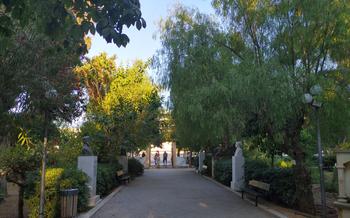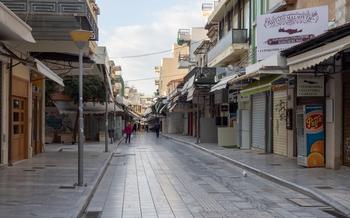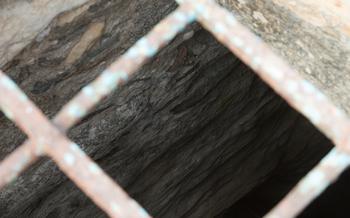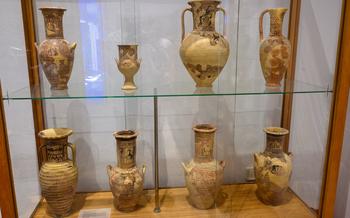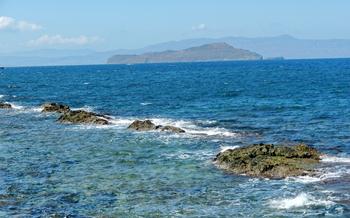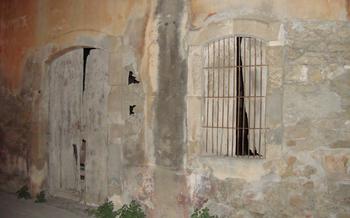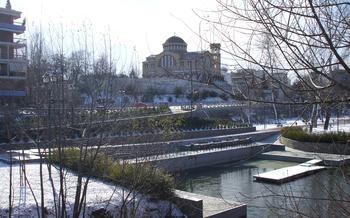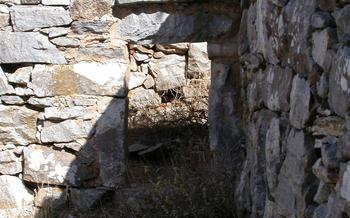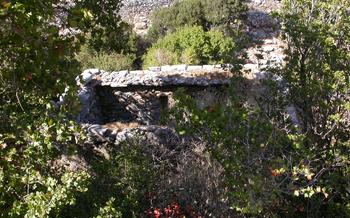
Fakistra Beach
- Natural beauty
- How to Get to Fakistra Beach
- What to Bring to Fakistra Beach
- Where to Stay Near Fakistra Beach
- Where to Eat Near Fakistra Beach
- Tips for Visiting Fakistra Beach
- History of Fakistra Beach
- Geology of Fakistra Beach
- Marine Life at Fakistra Beach
- Cultural Significance of Fakistra Beach
- Legends and Myths of Fakistra Beach
- Fakistra Beach in Popular Culture
- Insider Tip: Secret Swimming Spot
Natural beauty
Fakistra Beach is a hidden gem on the Pelion Peninsula, offering visitors a stunning combination of natural beauty, crystal-clear waters, and a secluded location.
Unique rock formations The beach is characterized by its unique rock formations, which create a dramatic backdrop for a day of sun and sea. The rocks are made of volcanic stone, and they have been eroded by the waves over time to create a variety of interesting shapes and sizes. Some of the rocks are large and jagged, while others are smooth and rounded. They create a natural playground for visitors to explore, and they also provide a great spot for taking photos.
Crystal-clear waters The waters at Fakistra Beach are crystal-clear, and they are perfect for swimming, snorkeling, and diving. The water is also very clean, and it is safe for children to swim in. The beach is located in a secluded bay, so the water is usually calm and free of waves. This makes it a great place to relax and enjoy a day of swimming and sunbathing.
Secluded location Fakistra Beach is located in a secluded location, away from the hustle and bustle of the city. This makes it a perfect place to escape the crowds and enjoy a peaceful day of relaxation. The beach is surrounded by lush vegetation, and it is only accessible by foot or by boat. This helps to keep the beach uncrowded, even during the peak summer season.
How to Get to Fakistra Beach
Driving Directions:
- From Volos, take the Küstenstraße in the direction of Agios Ioannis.
- After about 10 kilometers, turn left onto a small road that leads to Fakistra.
- Follow the road for about 2 kilometers until you reach the beach.
Public Transportation Options:
- There are no direct buses or trains to Fakistra Beach.
- The closest bus stop is in Agios Ioannis, about 2 kilometers from the beach.
- From Agios Ioannis, you can take a taxi or walk to the beach.
Hiking Trails:
- There are several hiking trails that lead to Fakistra Beach.
- One popular trail starts in Agios Ioannis and takes about 30 minutes to complete.
- Another trail starts in the village of Kala Nera and takes about 1 hour to complete.
Boat Tours:
- Several boat tours from Volos and Agios Ioannis stop at Fakistra Beach.
- These tours typically last for several hours and include swimming, sunbathing, and snorkeling.
What to Bring to Fakistra Beach
When packing for a day at Fakistra Beach, there are a few essentials you'll want to make sure to bring with you.
Beach Essentials:
- Sunscreen: The Greek sun can be intense, so it's important to protect your skin with a high-SPF sunscreen.
- Towel: A large, beach towel is a must for drying off after a swim or sunbathing.
- Hat: A hat will help keep the sun off your head and face.
- Sunglasses: Sunglasses will protect your eyes from the sun's harmful UV rays.
- Water bottle: It's important to stay hydrated, especially in the hot Greek sun. Bring a reusable water bottle and fill it up throughout the day.
Additional Items:
- Snorkeling gear: If you're planning on snorkeling, bring your own gear to avoid renting it.
- Hiking shoes: If you're planning on hiking to the beach, wear sturdy hiking shoes to protect your feet from the rough terrain.
- Camera: Bring a camera to capture the stunning scenery and memories of your day at Fakistra Beach.
Where to Stay Near Fakistra Beach
When planning a trip to Fakistra Beach, there are a variety of accommodation options available to suit different budgets and preferences. For those who prefer to stay in a bustling city with easy access to shops, restaurants, and nightlife, Volos is an excellent choice. The city offers a wide range of hotels, from budget-friendly options to luxury resorts, as well as convenient transportation links to the beach.
For travelers seeking a more secluded and relaxing experience, Agios Ioannis is an ideal base. This picturesque village, located just a short drive from Fakistra Beach, offers a variety of charming apartments and villas for rent. These accommodations often feature stunning views of the Aegean Sea and direct access to secluded coves and beaches.
For those who prefer to be surrounded by nature and enjoy camping under the stars, there are several options available near Fakistra Beach. The Agriolefkes Camping site, located a few kilometers from the beach, offers basic camping facilities, including tent pitches, shared bathrooms, and a communal kitchen. Alternatively, the Pilio Camping site in nearby Horto offers a more upscale experience with a swimming pool, restaurant, and various activities.
Where to Eat Near Fakistra Beach
After a day of swimming, sunbathing, and exploring Fakistra Beach, you'll probably be ready for a delicious meal. Fortunately, there are several great options for dining near the beach.
In the nearby village of Agios Ioannis, you'll find several fresh seafood restaurants where you can enjoy grilled fish, calamari, and other seafood dishes. Many of these restaurants have outdoor seating with stunning views of the Aegean Sea.
If you're looking for something more traditional, head to Volos, which is home to several traditional Greek tavernas. These tavernas serve up classic Greek dishes such as moussaka, pastitsio, and souvlaki. Many tavernas also offer live music and dancing, making for a lively and festive atmosphere.
For a more casual meal, you can find several beach bars and cafes along the coast near Fakistra Beach. These places offer a variety of snacks and drinks, as well as sun loungers and umbrellas for rent.
No matter what your budget or taste, you're sure to find something to satisfy your hunger near Fakistra Beach. So, relax, indulge, and enjoy the delicious flavors of Greece!
Tips for Visiting Fakistra Beach
To make the most of your visit to Fakistra Beach, here are a few tips to keep in mind:
- Avoid weekends and holidays: Fakistra Beach is a popular destination for locals and tourists alike, so it can get crowded on weekends and holidays. If you're looking for a more peaceful experience, try to visit on a weekday.
- Arrive early to secure a good spot: If you're planning on spending the day at Fakistra Beach, it's best to arrive early to secure a good spot. The beach can fill up quickly, especially during the summer months.
- Be aware of the currents: The currents at Fakistra Beach can be strong, so it's important to be aware of them when swimming. If you're not a strong swimmer, it's best to stay close to the shore.
- Bring plenty of water: There are no facilities at Fakistra Beach, so it's important to bring plenty of water with you, especially if you're planning on spending the day there.
History of Fakistra Beach
Ancient ruins
Fakistra Beach has been inhabited since ancient times, as evidenced by the ruins of a small settlement that are located near the beach. These ruins include the remains of several houses, a temple, and a theater. The settlement is believed to have been founded by the ancient Greeks in the 5th century BC, and it was likely abandoned in the 2nd century AD.
Mythological stories
Fakistra Beach is also associated with several mythological stories. One of the most popular stories is the story of the Argonauts. According to legend, the Argonauts landed on Fakistra Beach after their ship was damaged in a storm. The Argonauts were welcomed by the local people, and they stayed on the beach for several days to repair their ship.
Another popular story is the story of the Minotaur. According to legend, the Minotaur was a half-man, half-bull creature that was kept in a labyrinth on the island of Crete. The Minotaur was eventually killed by the hero Theseus, who escaped from the labyrinth with the help of Ariadne, the daughter of King Minos.
Modern development
In recent years, Fakistra Beach has become a popular tourist destination. The beach is easily accessible by car or public transportation, and it offers a variety of amenities, including restaurants, cafes, and sun loungers. Fakistra Beach is also a popular spot for swimming, sunbathing, snorkeling, and hiking.
Geology of Fakistra Beach
The unique rock formations at Fakistra Beach are the result of the area's unique geological history. The beach is located on the edge of a volcanic caldera, and the rocks that make up the beach were formed by the eruption of a nearby volcano. The lava from the volcano flowed into the sea, creating the unique rock formations that we see today.
The rocks at Fakistra Beach are also home to a variety of fossils, including seashells and fish bones. These fossils provide evidence of the ancient marine life that once inhabited the area. The volcanic activity that created the beach also created a rich mineral deposit, which has led to the formation of several hot springs in the area. These hot springs are a popular destination for tourists who come to Fakistra Beach to relax and rejuvenate.
The sea erosion at Fakistra Beach has also played a role in shaping the unique rock formations. The waves have eroded the volcanic rock, creating caves, arches, and other interesting features. The erosion has also exposed the different layers of rock, creating a colorful and textured landscape.
The geology of Fakistra Beach is a fascinating and complex topic. The beach is a reminder of the powerful forces that have shaped the Earth's surface over millions of years. It is also a reminder of the beauty and diversity of the natural world.
Marine Life at Fakistra Beach
Fakistra Beach is home to a diverse array of marine life, making it a popular spot for snorkeling and diving. The crystal-clear waters offer excellent visibility, allowing visitors to admire the colorful fish, sea urchins, and anemones that inhabit the underwater world. Dolphins are also known to frequent the area, adding to the marine biodiversity of Fakistra Beach.
Snorkeling enthusiasts can explore the shallow waters near the shore, where they will find a variety of marine life, including schools of colorful fish darting among the rocks. More experienced snorkelers and divers can venture further out to discover the deeper waters, where they may encounter dolphins, sea turtles, and other marine creatures.
The marine life at Fakistra Beach is a testament to the pristine condition of the environment. The clear waters and the abundance of marine life indicate that the ecosystem is healthy and thriving. Visitors to Fakistra Beach can enjoy the beauty of the underwater world while also appreciating the importance of protecting and preserving the marine environment.
Cultural Significance of Fakistra Beach
Fakistra Beach, nestled in the embrace of Volos, boasts a rich cultural tapestry woven from the threads of time. In ancient times, it was a refuge for weary travelers, who sought solace and rejuvenation in its tranquil embrace. The beach served as a natural harbor, welcoming weary seafarers who sought respite from the relentless waves. Over the centuries, Fakistra Beach evolved into a vibrant fishing village, where the locals plied their trade, casting their nets into the azure waters. The village exuded an air of authenticity, with its narrow cobblestone streets, whitewashed houses, and the tantalizing aroma of freshly caught fish. The convergence of cultures left an indelible mark on Fakistra Beach, enriching its heritage with diverse traditions and customs. Today, it stands as a symbol of resilience and continuity, a testament to the enduring spirit of the Greek people.
-
Local Festivals: The village of Fakistra celebrates its patron saint, Agios Ioannis, with an annual festival that draws visitors from near and far. The festivities commence with a grand procession through the village streets, accompanied by traditional music and dance. Locals donning colorful costumes gather in the town square to partake in lively celebrations, feasting on delectable local cuisine, and immersing themselves in the infectious rhythm of Greek music.
-
Historical Landmarks: Fakistra Beach bears witness to the passage of time, with historical landmarks that speak volumes about its rich past. The ruins of an ancient fortress, perched atop a hill overlooking the beach, offer a glimpse into the region's turbulent history. The fortress once served as a strategic defense against invaders, protecting the village and its people from harm. These remnants of the past stand as silent guardians, evoking a sense of awe and wonder in visitors who explore their ancient secrets.
Legends and Myths of Fakistra Beach
Fakistra Beach is steeped in ancient Greek mythology and modern folklore, making it a place of mystery and intrigue. According to legend, the beach was once home to the sirens, beautiful but deadly creatures who lured sailors to their deaths with their enchanting songs. Another myth tells the story of a young woman named Fakistra who was turned into a rock by the gods as punishment for her vanity.
Local folklore is also rich with tales of Fakistra Beach. One story tells of a ghost ship that appears on the horizon on stormy nights, searching for lost souls. Another legend speaks of a hidden treasure buried beneath the sand, waiting to be discovered by a worthy adventurer.
These legends and myths add to the allure of Fakistra Beach, making it a place that captures the imagination and invites visitors to explore its many secrets.
Fakistra Beach in Popular Culture
Fakistra Beach has also found its way into popular culture, inspiring artists and storytellers alike. The beach has been featured in several movies and TV shows, including the popular Greek film "Summer in Greece" and the international TV series "The Durrells." In literature, Fakistra Beach has been immortalized in the works of renowned Greek poets and writers, such as Nikos Kazantzakis and Kostas Karyotakis. The beach's unique beauty has also captured the attention of painters and photographers, who have created stunning artworks that showcase its natural wonders.
Insider Tip: Secret Swimming Spot
For those seeking an even more secluded swimming experience, there is a hidden cove located a short walk from Fakistra Beach. To find it, follow the path that leads along the coast to the right of the main beach. After about 10 minutes, you will reach a small clearing with a narrow opening in the rocks. This opening leads to a small, secluded cove with crystal-clear waters and a sandy beach. The cove is surrounded by high cliffs, which provide shelter from the wind and create a sense of privacy. It is the perfect place to relax and enjoy the beauty of nature without the crowds.
